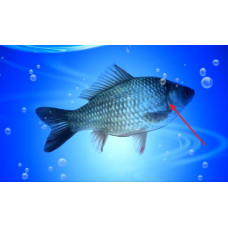The Latin Operculum is "lid.
Gill cover - consists of four bones that protect the gill apparatus of bony fish on each side of the head from damage. In front, it is movably connected with the head bones, and in the back it lies free, forming a slit for releasing water.
Flat skin formation in most fish (except for sharks and rays), as well as in the larvae of amphibians (tadpoles), the outside covering the gill slits and limiting the gill cavity - the space between the gills and the inner surface of the gill cover. In most cases, takes an active part in the act of breathing: when it rises, it creates a decrease in pressure in the gill cavity, and there through the gill apparatus receives water from the mouth and pharynx. In bony fish gill lids contain bones, and sometimes they have annual rings, and it makes it possible to determine the age of the fish.
Gill covers of bony fish that cover gill cavities and take part in the act of breathing consist of several (more often four) bones: preauricular (lat. praeoperculum), lid (operculum), subauricular (suboperculum) and interauricular (interoperculum). Consequently, reinforced by thin layers of bone movable gill cover not only covers and protects the gills, but also involved in the ventilation mechanism: it can close, tight against the body of fish, or open, regulating the flow of water inside through the gill cavity and its output outside.
During inhalation, the oral cavity expands, the pressure in it decreases and a portion of water is captured through the mouth opening. At the same time, the gill cover is pressed against the fish body under the pressure of the fluid from outside, preventing the entry of water from the gill cavity. At this time the gill cover muscles contract, which causes the gill cavity to expand and create a rarefaction in the gill cavity.
Water passing over the gills flows from the mouth cavity to the gill cavity due to the created pressure difference. This creates a continuous flow of fluid through the gills and gas exchange continues even when the fish take in new portions of water in their mouth.
The process of exhalation begins by closing the mouth opening and simultaneously raising the floor of the mouth - the liquid is squeezed through the gill slits in the gill cavity and, after passing over the gills, is released outside at the rear edge of the mobile gill cover, which opens the water pressure.
Thus, the coordinated action of the muscles of the oral cavity and the gill cover allows an almost continuous flow of water through the gills, maintaining a high concentration of oxygen and low carbon dioxide in the immediate vicinity of their surface.
Gill cover
Tags: gill cover

